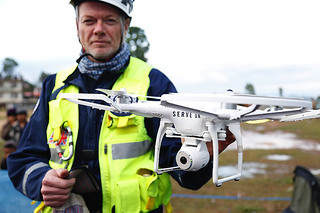Imagine Hilary Clinton receiving her hypothetical “3am phone call” and entering the situation room as a horrific hurricane batters the Gulf Coast. While USAID assesses the damage in the Caribbean, FEMA needs immediate, reliable, and detailed information to identify domestic needs.
Luckily, it’s 2016. Computer scientists have developed reliable tools to rapidly collect, interpret and transmit hyperlocal data. Their automated programs scour social media for signs of water and medicine shortages, and pinpoint collapsed buildings from drone footage. Within 24 hours, they turn around this information for rapid deployment of emergency response units.
Distraught relatives and empathetic onlookers feel an urgent need to help. As any good neighbor in the global village, they donate money and goods. But they also donate their attention–whether through translating emergency SMS messages, classifying tweets, or tracing aerial images of disaster zones.
While policymakers brace for a climate with more frequent and destructive disasters, this is the technological and social future of humanitarian response. Optimizing information flow can and will save lives. Skeptics need look no further than the global response to April’s massive earthquake in Nepal for current and practical examples.
Patrick Meier’s engaging and insightful book, Digital Humanitarians, describes the online parallel of crisis management, as the increasing demand for emergency data is met by online volunteers and data experts. An acclaimed thought leader on crisis mapping since the 2010 Haiti earthquake, Meier is well positioned to explain technical text mining methodologies and the complications of automated satellite imagery analysis. Yet Digital Humanitarians is not really a book about technology. Meier’s connected colleagues gracing the book’s cover are tech-savvy, sure, but they are essentially smart, generous people who feel just at home in Haiti as at SXSW. Meier fittingly calls these folks “Information DJs”: they know how the tools work, although they are much more interested in coordinating group action. I like to imagine enlightened policymakers are the MCs, club promoters, producers, bouncers, and roadies who condition and facilitate this self-organization.
Meier notes that the humanitarian space is “ripe for innovations in policy”. So what should young policymakers know about digital tools applied to disaster relief? To find out, I sent some questions to Meier. His responses, provided with the help of his research assistant, Peter Mosur, are below.
Q&A with Patrick Meier:
Brian: “You mention the need for “enlightened leadership” to empower digital humanitarians, such as coordinating disaster relief hashtags and establishing data privacy protocols. But what sorts of public policies are needed to catalyze innovation in emergency response and preparedness?”
Patrick: “We need public policy that supports the adaption of new technologies and the creation of procedures involving UAVs in emergency response and preparedness. There is a wealth of information available in the world held by everyday individuals after a disaster. Public agencies need to learn how to tap into these resources efficiently, and what they can do with the data. Policy is the only thing that can push it to the forefront.”
Brian: “The latest UN report on humanitarian UAVs says “the biggest challenges to expanding the use of UAVs are legal and regulatory”. In your opinion, whats the biggest policy constraint for wider UAV use in humanitarian situations? Did the humanitarian UAV community have any influence during development of the FAA’s recent UAV regulations?”
Patrick: “It unfortunately did not. This is one area that we are hoping we could influence the FAA to create laws allowing humanitarians to fly UAVs for humanitarian aid.”
Brian: “The most useful datasets are generally comprehensive (large), accurate (valid), representative (detailed), and timely (updated), but it can be really difficult to rapidly and accurately update a complex database. Plus, the sheer size of spatial and social data available for humanitarians will continue to grow, while machine learning makes analyzing these vast data stores much quicker. Looking at where the field is going, what kinds of data should future policymakers expect to see? Will the next big gains in humanitarian data quality come from data accuracy, detail, or timeliness?”
Patrick: “Timeliness is something which most researchers, such as myself, are actively working on. Detail is hand in hand with timeliness, and both are dependent on the amount of volunteers we have or the accuracy of our algorithms. The algorithms are actually trained by the volunteers, so breakthroughs in crowdsourcing would prove vital to humanitarian data quality. Data accuracy is similarly related to these concepts, but it is also dependent on the individuals providing the information in the first place. Going back to policy, everyday people need to know which data is most valuable in a disaster as well as the correct methods of distributing them. If everyone became an expert disaster reporter overnight, the effect would be massive.”
Brian: “I’ve heard it said that machine learning is like training a really smart infant. Classification algorithms of social media or aerial satellite imagery work well in the contexts for which they are designed, but they are helpless outside of their learning environment. From a development perspective, this reminds me a lot of Randomized Controlled Trials (RCTs). But like RCT meta-analysis or 538’s political polls, aggregation of results could deliver valuable insights. Is there an effort to pool data and algorithms from different disasters together?”
Patrick: “This is something which is being worked on through AIDR [Artificial Intelligence for Disaster Response]. We have categories of disasters, such as earthquakes or tornadoes. The ultimate goal is to have classifiers trained in each type of disaster so that we could deploy them at a moments notice.”
Brian: “Lastly, a more open question: what is the most important thing for young international policymakers to know about humanitarian technologies?”
Patrick: “The most important thing they should know is that technology will not solve all problems.”
Edited by Jon Brandt

